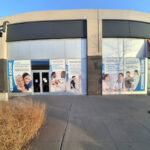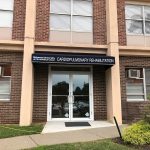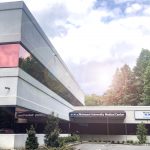Spinal Stenosis Treatment and Surgery in Staten Island, NY
Spinal stenosis is a medical condition that causes a narrowing of the spinal canal. It either develops over time or occurs naturally at birth. People with spinal stenosis may experience a variety of symptoms, many of which do not require treatment until the disease has progressed. Treatments range from medications and physical therapy to more serious methods, like surgery.
Patients across Staten Island, NY, can discuss their treatment options with our team of skilled, trained medical professionals at Richmond University Medical Center. Learn more about spinal stenosis and the treatments offered at our facility.
What Is Spinal Stenosis?
The spinal canal is a hollow space that passes through the vertebrae. This is where the spinal cord is stored. When the spinal canal becomes narrow, it might be a sign of spinal stenosis – a common spine disorder. As the spine narrows, it causes the spinal cord or nerve roots to become constricted. This creates intense pressure and irritation on these spinal systems, producing uncomfortable symptoms, such as:
- Balance issues
- Radiating pain
- Numbness
- Tingling
- Weakness
Symptoms can grow worse over time or with increased physical activity. Patients may also experience periods where they have no symptoms, but eventually, symptoms return. Symptoms can range from a
mild ache to a harsh, burning feeling. In some instances, a patient might have spinal stenosis but no symptoms. This often means the disease is still in its early stages. Early cases of spinal stenosis still appear on certain imaging tests, like X-rays.
However, spinal stenosis can also worsen, potentially leading to paralysis or severe weakness. It may cause other problems, like sciatica. This makes it important to receive regular testing early, especially if a patient is susceptible to the disease. Early detection can allow for quicker treatment and better quality of life.
Types of Spinal Stenosis
Spinal stenosis most commonly develops in two areas of the spine:
Lumbar Vertebrae
Lumbar vertebrae are located in the lower back. There are five vertebrae in the lumbar area of the spine, which are some of the largest in the spine system. Lumbar spinal stenosis is the most common type of spinal stenosis found in patients. Patients with this type of disease may experience varying symptoms, such as pain in the lower back or thigh, aches that decrease when leaning forward or sitting, leg cramping, or worsening pain when standing.
Cervical Vertebrae
Cervical vertebrae are found in the neck, and they consist of seven different vertebrae. Those with cervical spinal stenosis may have varying symptoms that are unique to the neck area, like trouble with hand function or pain in the neck.
In rare cases, spinal stenosis can also develop in the middle back (thoracic spine). This disease can also arise in many different spine areas. For example, vertebrae have openings that allow nerves to disperse through other parts of the body. Spinal stenosis can develop here, as well.
What Causes Spinal Stenosis?
The most common cause of spinal stenosis is aging. This is because aging naturally causes bones and other essential body parts to weaken. This includes the spinal cord, which can change over time. Ligaments found in vertebrae harden and become thick, and joints and bones become enlarged. This leaves less space for the spinal cord and nerves, allowing spinal stenosis to develop.
While less common, spinal stenosis might also come about during fetal development, either through a birth defect, natural narrowing of the spinal cord, or spine curvature. Patients may also develop the disease through an inherited condition, like achondroplasia dwarfism, congenital stenosis, or scoliosis. Having certain medical conditions can also increase the chances that a patient develops spinal stenosis in the future, such as:
- Paget’s disease
- Osteoarthritis
- Bone tumors
- Rheumatoid arthritis
- Bone spurs
- Herniated discs
- Spondylolisthesis
Additionally, those who have a current or previous back injury, like fractures or other trauma, can be more susceptible to developing spinal stenosis.
Treatments for Spinal Stenosis
The right treatment for spinal stenosis depends on many factors, such as the severity, cause, and location of the patient’s condition. For mild symptoms, physicians typically recommend less drastic treatments, like increasing exercise, building strength and flexibility, or placing a heat or cold pack on the affected area. Physicians may also prescribe medications, physical therapy, or certain injections.
However, if these treatments fail to work, physicians may advise that a patient undergo surgery. The different spinal stenosis surgery methods include:
Laminectomy
A laminectomy requires surgeons to remove a portion of the patient’s vertebra called the lamina. This type of surgery is the one most commonly used to treat spinal stenosis. Surgeons remove the portion of the vertebrae generating symptoms and potentially the surrounding bone spurs and ligaments. This method of treatment works to create space for the spinal cord and nerves, which relieves aches and pains associated with the disease.
Foraminotomy
Foraminotomy procedures are completed in the area in which nerve roots leave the spine, called the foramen. During the surgery, surgeons carefully remove the bone or surrounding tissues. Because neurosurgeons are dealing with the spine’s nerves, careful tactics are used to complete the surgery.
Fusion Procedure
A fusion procedure, also called a spinal fusion, is designed to stabilize the backbone by conjoining two vertebrae together. This is typically a last-resort surgery if other treatment methods have not worked.
Laminoplasty
This type of surgery is mostly used to treat cases of cervical spinal stenosis. Similar to a laminectomy, a laminoplasty involves removing a part of the lamina to create more room in the spinal canal. With this procedure, surgeons must screw a metal plate across the space where the bone was removed.
Services Offered at Richmond University Medical Center
The team of board-certified neurosurgeons at Richmond University Medical Center provide a variety of surgeries and other spinal stenosis treatment methods, including laminectomy and spinal fusion procedures. Other surgeries they provide include:
- Trauma surgery
- General and ambulatory surgery
- Thoracic surgery
- Minimally invasive surgeries
- Neurosurgery
With extensive experience treating many cases of spinal stenosis, RUMC physicians have the advanced tools and skill set to treat mild to severe symptoms. During the first appointment, physicians conduct a physical exam to gain an understanding of a patient’s condition. From there, they complete further imaging tests to determine the location and cause of symptoms. Once a patient is diagnosed with spinal stenosis, physicians construct a treatment plan that works for their unique situation.
To begin treatment, physicians typically prescribe medications, recommend lifestyle changes, and enroll patients in physical therapy. In many cases, these treatments work to relieve symptoms. However, in more severe instances of spinal stenosis, the patient requires surgery. The physicians at Richmond University Medical Center will explain the risks and benefits and recommend the best surgical technique to ensure patients receive the care they need.
Contact Richmond University Medical Center Today
Patient care is a top priority at Richmond University Medical Center. Using a comprehensive, compassionate approach to medical diagnoses and treatments, physicians offer patients across Staten Island, NY, care for a range of conditions. To learn more about the spinal stenosis treatments offered at Richmond University Medical Center, contact us today.



